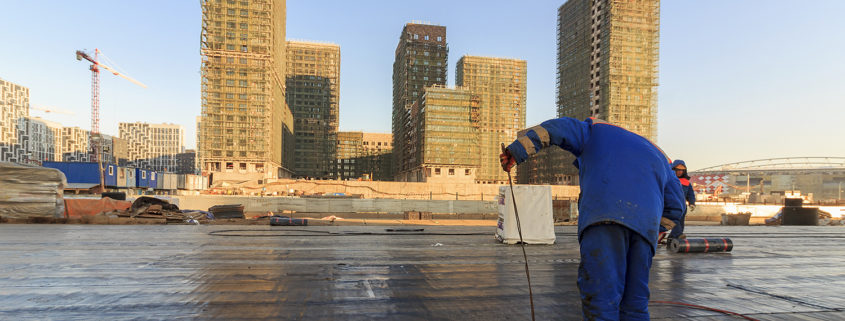A Built-Up Roof (BUR) system is time-tested and reliable. The durability and reliability of built-up roofing systems are exactly why BURs have been in continual usage for American commercial buildings for over a century and a half. However, with that performance comes maintenance and repair issues unique to built-up roofs. We’ll talk about what those are and also discuss key advantages and disadvantages to built-up roofs. Is a BUR system right for your building?
What is a Built-Up Roofing System?
Built-up roofing has been utilized in American commercial roofing applications since roughly the 1840s and is found on low-slope roofs or flat roofs.
Built-up roof systems are constructed of three main components: Bitumen material, ply sheets, and some kind of coating material.
The bitumen material is usually coal tar, also known as asphalt, and it’s widely recognized as a natural waterproofer. Synthetic bitumen materials are becoming increasingly prevalent since they do not need to be heated, like coal tar does. When many people think of commercial roofing installation, they think of a hot asphalt roof, even though there are many commercial roofing types.
Ply sheets are fabric sheets or felts that are reinforced, usually with fiberglass. A base sheet of insulation is placed and the layers of the reinforcing fabric are sandwiched together with layers of bitumen to “build up” the roof and create the roof membrane.
The top layer of a BUR system is a layer of aggregate material, usually gravel or some type of mineral granules. A BUR system can also be topped with a mineral-surfaced cap sheet. Finally, a finishing layer of asphalt, an aluminum or a polymer coating is applied.
Pros and Cons of Built-Up Roofing
Are you considering a BUR roofing system for your commercial building? Let’s look at the advantages and disadvantages this widely utilized option.
Built-Up Roofing Advantages
The methods behind built-up roofing are time-tested by roofers worldwide, and the practice, although modernized, has changed very little since the early 1800s. Asphalt has been used throughout the centuries by civilizations around the world as a waterproofing agent. So building owners can rest assured that the roofing materials used in built-up roofing are dependable.
A built-up roof offers an excellent fire-resistant layer onto your commercial building. It takes a lot of heat to ignite asphalt, and that, combined with the multiple layers of roofing felts and an aggregate layer provide a strong barrier against fire.
Built-up roofs are also very resistant to harsh weather conditions and foot traffic. Always consider the frequency and severity of storms and bad weather when considering a roof for your commercial building – other types of roofing material, such as single-ply roofing might not stand up to harsh conditions the way that a built-up roof can.
Another great advantage of built-up roofing is the cost. BUR roofing is often lower in cost per square foot when compared to other roofing types (like metal roofs), which makes the BUR system very attractive to business owners. Plus, most new built-up roof systems are designed to reflect UV rays, increasing the building’s energy efficiency and saving money in the longrun.
Built-Up Roofing Disadvantages
Like any roofing system, built-up roofs also come with some disadvantages that may not make it a suitable choice.
If the aggregate material on the roof surface is blown around or disturbed, it can expose the underlying surface to weather and harsh elements. If left exposed for a long period of time, seams can dry out and crack, allowing water under the surface and causing blisters. Ponding can also be a serious problem, as it is for any roof.
Most of these problems, however, can be avoided by having regular roof inspections performed by a trusted roofing contractor. A built-up roof may be low maintenance, but you still need a trusted roofing company to take care of it in order for it to achieve its maximum lifespan.
Taking Care of Your Built-Up Roof
Just because a built-up roof is low maintenance does not mean that it’s maintenance-free. You still need to take care of it in order to avoid costly roofing repairs in the future. Like we mentioned above, regularly scheduled roof inspections save a lot of headaches when it comes to taking care of your roof. If an inspection discovers a problem, be sure to have it fixed immediately. A roof issue won’t get better over time – it will only get exponentially worse.
About every five years, a built-up roof’s ultraviolet protection layer must be reapplied. In order to reapply this layer, the entire roof must be inspected to make sure that all of the seals are intact and that all of the roof’s flashings are still properly fitted. (This layer is different from waterproofing and is only there for protection against the sun’s UV rays.)
If any leaks or cracks are found, they must be properly resealed before the application of a new UV protection layer can start. Any worn out flashings need to be replaced and the roof deck needs to be completely cleaned of leaves and other debris. Only then will the roof be prepared to accept a new layer of UV protective coating. This might seem like a hassle, but it will ensure that your built-up roof is ready to keep doing its job for many more years.
A well-maintained built-up roof can have a lifespan of anywhere from 20-35 years and perhaps even longer, depending on the local climate and conditions. (Built-up roofing does last a few years longer in warmer climates versus colder ones.)
TEMA Roofing, the Built-Up Roof Experts
If you’re looking for built-up roof maintenance, new installation, or simply need to have your BUR system inspected, contact us at TEMA Roofing Services. We have the expertise to fully understand your roofing needs and give you the best solution for your commercial roof.





